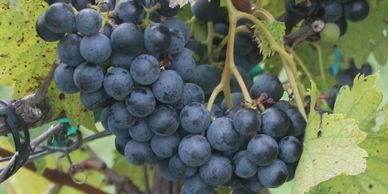Growing in the Vineyard
Chambourcin
Chambourcin
Chambourcin

Chambourcin is a French hybrid produced by Joannes Seyve by crossing Seyve-Villard with Chancellor. It is named after the Chambourcin area in south-eastern France where Seyve had an experimental vineyard. The grape has only been available since 1963.
Fredonia
Chambourcin
Chambourcin
Fredonia is an American hybrid obtained by the New York Sate Agriculture Experimental Station in 1915. DNA shows it is a Champion and Lucille cross making it a cousin to the Concord. These cold-hardy vines produce large to medium-sized compact bunches of thick-skinned berries.
Melody
Chambourcin
Niagara
Melody is related to the Cayuga White. It resulted from the cross of Seyval with Geneva White 5 produced by Cornell University in 1965. Fruit was first observed in 1969, but the vines were not officially released as Melody until 1985.
Niagara
Seyval Blanc
Niagara
These medium to large bunches of thin-skinned berries are vigorous and productive. Claudius Hoag and B Wheaton Clark, private growers in New York, created the Niagara by crossing the Concord with Cassady in 1866. Niagara is named for Niagara County, New York where it was first produced.
Norton
Seyval Blanc
Seyval Blanc
Norton, an American hybrid, is widely grown in the American Northeast and Midwest. There are conflicting theories of its origin. While originally thought to be separate varietals, recently DNA studies have proven that the Norton and the Cynthiana are the same grape.
Seyval Blanc
Seyval Blanc
Seyval Blanc
Seyval Blanc is a French hybrid produced from the crossing of Seibel 5656 and Rayon D'or. The grapes ripen early and have consistently high yields. Seyval Blanc has been used to breed with Cayuga White, Chardonel, Melody and more.
St. Vincent
St. Vincent
St. Vincent

While the exact pedigree of the St. Vincent grape is unknown, it was first discovered in 1973 in Augusta, Missouri. It is thought that it is a chance cross between the Chambourcin and Pinot Noir. It is said to be named after the patron saint of vineyards, St. Vincent.
Traminette
St. Vincent
St. Vincent

Trying to get a large-cluster table grape with Gewurztraminer flavor, Herb Barret at the University of Illinois bred a Joannes Seyve 23-416 with Gewurztraminer producing the Traminette. This American hybrid is rapidly becoming a popular grape in the Midwest and Northeast.
Vidal Blanc
St. Vincent
Vidal Blanc
In France during the 1930s, Jean-Louis Vidal originally crossed a Trebbiano Toscano and Rayon D'or to find a grape suitable for making Cognac. The Vidal grape was born. Vidal has the great advantage of being winter-hardy with long bunches of small berries.
Vignoles
Blackberries
Vidal Blanc

Recent DNA analysis has raised doubts about the parentage of the Vignoles. It was originally thought it was a French hybrid, a cross between Subereux and Pinot Noir. Late budding makes the Vignole less susceptible to frost damage, yet has low yields of small tightly packed bunches of very small berries.
Mars
Blackberries
Blackberries

A hardy seedless table grape with medium-sized berries in compact clusters. Mars has a Concord-like flavor and are great for fresh eating.
Blackberries
Blackberries
Blackberries

Triple Crown thornless blackberries are known for their flavor, productivity, and vigor. They are large, juicy, and sweet, perfect for winemaking.
Copyright © 2023 Davenport Winery - All Rights Reserved.
Powered by GoDaddy Website Builder